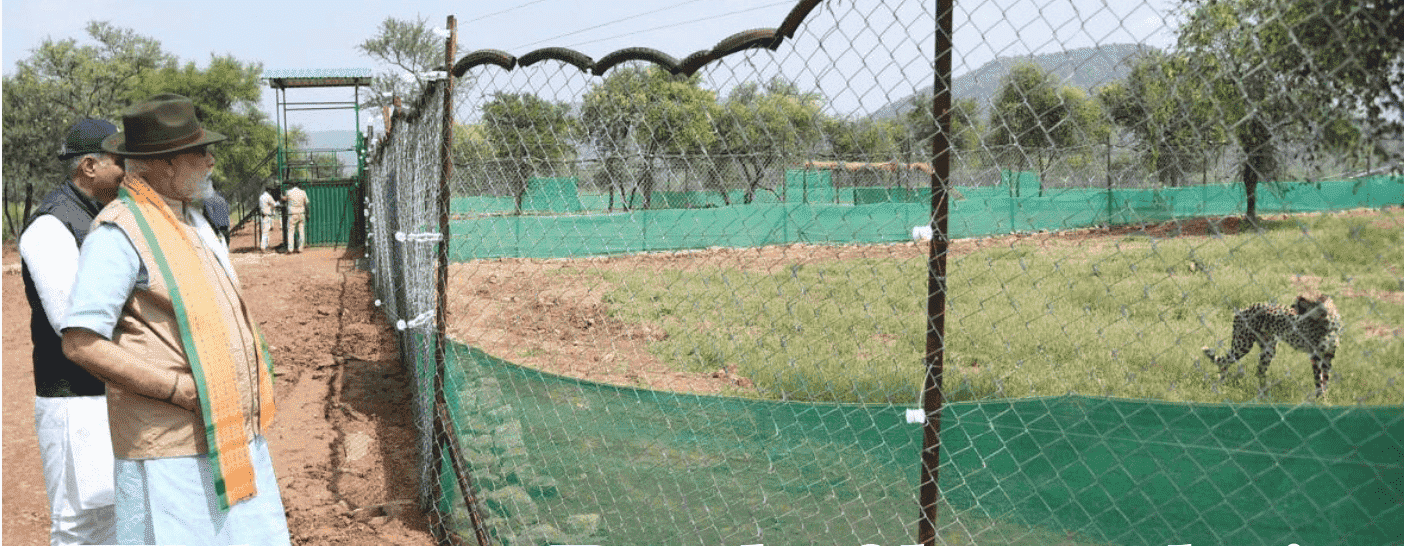
Cheetahs welcomed in India by PM Modi in September 2022, quarantined for health checkups. No one is a stranger to the big news about eight cheetahs being brought to India on Prime Minister Modi’s birthday. Cheetahs were declared extinct in India around 1948, primarily due to habitat reduction and over-hunting. Since the government declared the cheetah extinct, plans were drawn up to bring them back from foreign countries like Iran. From the extinction to bringing them back, 26 years have passed, and the cheetah reintroduction plan has just started. Formal proposals to bring back cheetahs were drawn up in 1955, starting in Andhra Pradesh. These proposals prompted the government to bring back the cheetahs for experimental purposes. Initially, it was planned that India would acquire the cheetahs from Iran, and while the two countries shared multiple diplomatic level talks, due to Iran’s domestic issues, the plan could not go further. In later years the number of cheetahs in Iran decreased, making it hard for India to get Cheetahs from them. On the side, Kenya was sending multiple offers to the Indian government about sending their cheetahs. Initiation and Early Steps In 2009 Laurie Marker, who is also the supervisor of the Cheetah project now in India, introduced the plan to relocate South African cheetahs to India and keeping them under strict supervision. Wildlife Institute of India (WII) and Wildlife Trust of India (WTI) were also a part of this meeting alongside many other significant NGOs. After the Ministry of Environment, Forest and Climate Change approved the plan, the tiresome process of relocations started, with the biggest question being –– “Where will the cheetahs live?” According to the then government, the following places were being discussed as potential habitats: 1. Kuno Palpur National Park Kuno being the highest rated, became the number one choice for everyone to bring cheetahs in for the initial stages. However, the plan did not materialise immediately. With multiple bumps around the way, on 17th September 2022, eight cheetahs were brought to India from Namibia. The cheetahs have been put in quarantine for a month and have been installed with digital chips to help their caretakers keep track of them. They will then be introduced to small areas of the park slowly till they get used to their environment. The cheetahs have been put in quarantine for a month and have been installed with digital chips to help their caretakers keep track of them. They will then be introduced to small areas of the park slowly till they get used to their environment. Future Plans There are big plans made by the government to increase the cheetah population in India. Aside from breeding, twelve more cheetahs will be brought from South Africa in October 2022. If the breeding process goes according to the plan and a few more cheetahs are brought in, the number would significantly increase. Then the cheetahs can be sent to other national parks in different locations. Cheetahs were the first species in India that went extinct due to unnatural issues, these big cats are what India used prides itself about. If the project goes as planned, then India will soon be able to pride itself on its cheetahs once again. India is ready to welcome the fastest land animal back, and this time with more planning and positivity. With multiple bumps around the way, on 17th September 2022, eight cheetahs were brought to India from Namibia. The cheetahs have been put in quarantine for a month and have been installed with digital chips to help their caretakers keep track of them. They will then be introduced to small areas of the park slowly till they get used to their environment.
2. Nauradehi Wildlife Sanctuary
3. Gandhi Sagar Wildlife Sanctuary
4. Shahgarh bulge
5. Mukundara Tiger Reserve
10 Oct 2022
Ikshaa Dhodi